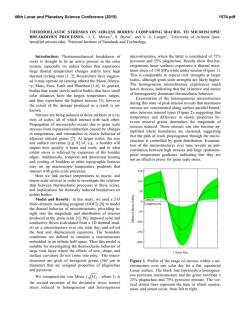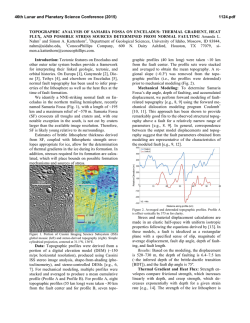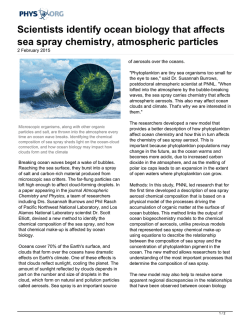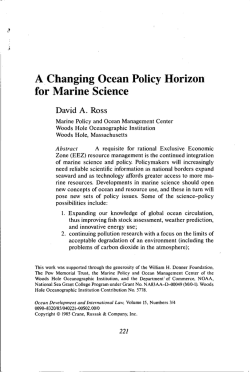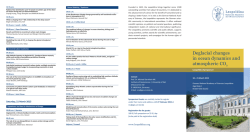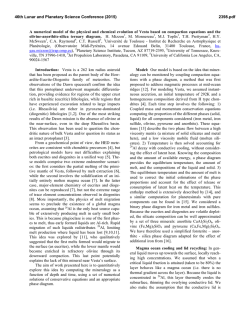
TESTING THE MIMAS OCEAN HYPOTHESIS USING TIDAL
46th Lunar and Planetary Science Conference (2015) 2379.pdf TESTING THE MIMAS OCEAN HYPOTHESIS USING TIDAL-TECTONIC THEORY. Alyssa R. Rhoden1, Radwan Tajeddine2, Wade Henning3, and Terry A. Hurford4, 1JHU-APL, 11101 Johns Hopkins Rd., Laurel, MD, 20723 2Cornell University 3University of Maryland – College Park 4NASA GSFC. Introduction: Analysis of Mimas’ orbital motions revealed physical librations at several frequencies, which were used to constrain Mimas’ interior structure [1]. The observations indicate that Mimas either has a highly elongated core or an internal ocean. In the ocean case, the thickness of the overlying ice and its viscosity are further constrained by the librations [1]. Because of its high present-day eccentricity, an ocean within Mimas could induce surface tidal stresses similar to those inferred for Europa [e.g. 2] and Enceladus [3][4]. However, unlike those satellites, Mimas’ surface is heavily cratered and nearly devoid of fractures (Fig. 1). The purpose of this study is to determine whether a subsurface ocean is compatible with the lack of tidal-tectonic activity observed on Mimas. We calculate the magnitude of the principal tidal stresses that would be generated on Mimas using three interior structure models, each of which include an ocean and have shell thicknesses and viscosities consistent with the observed librations [1]. Considering only the effects of eccentricity-driven tidal stress, we find that interior structure models with oceans would induce maximum tensile stresses between 170 kPa and 3 MPa. These stress magnitudes exceed those inferred for fracture formation on Europa. The lowest viscosity case exceeds the failure strength of terrestrial ice. The stresses we calculate are likely a lower bound because physical libration will also generate tidal stress (as in [2], for Europa). Based on these results, we can rule out the lowest viscosity end-member of the ocean models presented by [1]. We further conclude that, even with a higher ice shell viscosity, Mimas’ surface must have a higher failure threshold than Europa’s to remain inactive in the presence of an ocean. If Mimas’ ocean were confirmed, it would provide an avenue for disentangling the effects of stress sources and ice shell properties in controlling tidal-tectonic activity on icy satellites. Figure 1: Mimas’ heavily cratered surface, as imaged by Cassini, shows no evidence of tidal fractures like those on Europa and Enceladus. Methodology: We calculate tidal stresses in a rheologically-layered body, following the formulation of [5], which utilizes the propagator matrix method. We have validated the code against published results for Europa [5]. Details of our methodology are provided in [6] for Pluto’s moon, Charon. The interior structure models we test include an ocean layer underneath an ice shell. The shell is further separated into a ductile lower layer and a 1-km-thick brittle upper layer. Shell thickness and viscosity values for each case are listed in Table 1. Parameter values were chosen based on the reported values from [1]. For numerical stability, the brittle and ductile layers cannot have exactly the same viscosity, so we use 1.2x1021 Pa*s for the brittle layer in the “high-viscosity” case. Additional parameter values, held constant across all simulations, are listed in Table 2 (from [7]). For each interior structure model, we calculate the principal tidal stresses at 48 timesteps within an orbit, at every 30° of longitude, and at every 15° of latitude (following [5]). We then identify the maximum (tensile) stress for that interior model. Our tidal stress calculations include only the contribution from Mimas’ orbital eccentricity. Mimas also has a physical libration at the orbital period [1], which we will incorporate in future work. Table 1: Interior structure test cases LowMediumviscosity viscosity Total shell 24 km 26 km thickness Ductile ice 1012 Pa*s 1016 Pa*s viscosity Brittle ice 1021 Pa*s 1021 Pa*s viscosity Highviscosity 31 km 1021 Pa*s 1.2x1021 Pa*s Table 2: Additional simulation parameters Period (d) 0.942 Current eccentricity 0.0196 Surface gravity (m/s2) 0.06 Radius (km) 198.2 Surface rigidity (Pa) 3.487x109 Results & Discussion: We find maximum tensile tidal stresses of 2.937 MPa, 194 kPa, and 168 kPa for the low, medium, and high-viscosity cases, respectively. In all cases, the stresses are well-distributed in space and time (Figs. 2 & 3). In other words, the maximum stress values are not outliers. 46th Lunar and Planetary Science Conference (2015) Lab studies suggest that, at temperatures relevant for icy satellites, the failure strength of water ice is >1 MPa, and may even be as much as a few MPa [8]. Based on the distribution of stresses >1 MPa in the low-viscosity case (Fig. 2), we would expect Mimas’ surface to be pervasively fractured. Therefore, we can rule out the low-viscosity, sub-surface ocean model. At Europa, tidal stresses due to eccentricity peak at ~100 kPa [2], which is an order of magnitude lower than the expected failure strength of ice. However, the surface is pervasively fractured, and the paths and distributions of fractures are well-matched to diurnal tidal stress patterns (e.g. [9]). Furthermore, the fractures correspond to stress contours between 20 and 90 kPa [2][10]. The stresses on Mimas, using the medium and high viscosity models, are several times larger than these inferred values for Europa (Fig. 3). Therefore, in order for the ocean model to be consistent with the lack of observed tidal-tectonic activity, Mimas’ surface must have a higher failure threshold than Europa’s. The reason for Europa’s apparently low failure threshold is unknown. One possibility is that an additional source of stress, such as thermal stress from ice shell cooling or stress from non-synchronous rotation [9], amplifies the diurnal tidal stress enough to cause failure. Alternatively, Europa’s surface may be weaker than expected from lab tests. For example, some terrestrial analogs have failure thresholds closer to 100 kPa [11]. If Mimas does have an internal ocean, its lack of fractures provides important constraints on its stress environment and failure threshold, which has implications for conditions at Europa and other icy satellites. Conclusions: The presence of a subsurface ocean within Mimas has implications for the formation timescale of the Saturnian satellites, the mechanism for maintaining liquid water oceans within icy moons, and the processes associated with tidal-tectonics. We have assessed whether a subsurface ocean is compatible with the lack of tidal-tectonic activity observed on Mimas’ surface. We find that the eccentricity stresses are comparable to those on tidally-active Europa, which suggests that an elongated core may be more compatible with Mimas’ lack of tectonic activity than the ocean model. However, we find that such activity may be sufficiently restricted in an ocean model if the ice shell has moderate to high viscosity and has a higher failure threshold than Europa’s ice. Therefore, the ocean model may indeed be viable. Independent constraints on the viscosity of Mimas’ ice shell, such as from models of crater relaxation, would help distinguish between an ocean and an elongated core. References: [1] Tajeddine R. et al. (2014) Science, 346, 322-324. [2] Rhoden A.R. et al. (2010) Icarus, 210, 770-784. [3] Hurford T.A. et al. (2007) Nature 2379.pdf 7142, 292-294. [4] Nimmo F. et al. (2007) Nature 7142, 289-291. [5] Jara-Orue H.M. and Vermeersen B.L.A. (2011) Icarus, 215, 417-438. [6] Rhoden A.R. et al. (2015) Icarus, 246, 11-20. [7] Matson D. et al. (2009) In: Saturn with Cassini-Huygens, 577-612. [8] Collins G. et al. (2009) In: Planetary Tectonics, 264350. [9] Kattenhorn S.A. and Hurford T. (2009) In: Europa, 199-236. [10] Rhoden A.R. and Hurford T.A. (2013) Icarus, 226, 841-859. [11] Barr A.C. and Showman A.P. (2009) In: Europa, 405-430. Figure 2: As shown in the histogram, the max principal stress is >1 MPa at more than half of the locations and times we tested, using the low-viscosity model, which should be causing pervasive fracturing on Mimas. Figure 3: In the high-viscosity case, more than half the location-times experience max principle stresses >50 kPa, similar to failure stresses inferred for Europa [2].
© Copyright 2025


